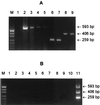Direct detection of Shiga toxigenic Escherichia coli strains belonging to serogroups O111, O157, and O113 by multiplex PCR
- PMID: 10488207
- PMCID: PMC85568
- DOI: 10.1128/JCM.37.10.3362-3365.1999
Direct detection of Shiga toxigenic Escherichia coli strains belonging to serogroups O111, O157, and O113 by multiplex PCR
Abstract
Shiga toxigenic Escherichia coli (STEC) strains are a diverse group of organisms associated with severe gastrointestinal and systemic diseases in humans. Within the STEC family, eae-positive STEC strains, particularly those belonging to serogroups O157 and O111, appear to have greater virulence for humans. However, in spite of being eae negative, STEC strains belonging to serogroup O113 have frequently been associated with cases of severe STEC disease, including hemolytic-uremic syndrome (HUS). We have developed a modified multiplex PCR assay for detection of STEC strains belonging to these three serogroups in cultures of feces by using primers specific for portions of the genetic loci (rfb) encoding biosynthesis of the respective O antigen. These primers direct amplification of PCR products of 259, 406, and 593 bp for serogroups O157, O111, and O113, respectively. The assay was validated by testing 40 previously characterized STEC strains, with 100% agreement. It also detected STEC strains of the appropriate genotype in primary fecal cultures from 13 patients with HUS or bloody diarrhea. Thirty other primary fecal cultures from patients without evidence of STEC infection were negative.
Figures



Similar articles
-
Detection and characterization of Shiga toxigenic Escherichia coli by using multiplex PCR assays for stx1, stx2, eaeA, enterohemorrhagic E. coli hlyA, rfbO111, and rfbO157.J Clin Microbiol. 1998 Feb;36(2):598-602. doi: 10.1128/JCM.36.2.598-602.1998. J Clin Microbiol. 1998. PMID: 9466788 Free PMC article.
-
Applicability of a multiplex PCR to detect the seven major Shiga toxin-producing Escherichia coli based on genes that code for serogroup-specific O-antigens and major virulence factors in cattle feces.Foodborne Pathog Dis. 2012 Jun;9(6):541-8. doi: 10.1089/fpd.2011.1082. Epub 2012 May 8. Foodborne Pathog Dis. 2012. PMID: 22568751
-
Molecular characterization of the locus encoding biosynthesis of the lipopolysaccharide O antigen of Escherichia coli serotype O113.Infect Immun. 1999 Nov;67(11):5930-7. doi: 10.1128/IAI.67.11.5930-5937.1999. Infect Immun. 1999. PMID: 10531250 Free PMC article.
-
Prevalence of shiga toxin-producing Escherichia coli in dairy cattle and their products.J Dairy Sci. 2005 Feb;88(2):450-65. doi: 10.3168/jds.s0022-0302(05)72706-5. J Dairy Sci. 2005. PMID: 15653509 Review.
-
Prevalence and pathogenicity of Shiga toxin-producing Escherichia coli in beef cattle and their products.J Anim Sci. 2007 Mar;85(13 Suppl):E63-72. doi: 10.2527/jas.2006-421. Epub 2006 Oct 23. J Anim Sci. 2007. PMID: 17060419 Review.
Cited by
-
Direct detection and characterization of Shiga toxigenic Escherichia coli by multiplex PCR for stx1, stx2, eae, ehxA, and saa.J Clin Microbiol. 2002 Jan;40(1):271-4. doi: 10.1128/JCM.40.1.271-274.2002. J Clin Microbiol. 2002. PMID: 11773130 Free PMC article.
-
Detection of Shiga toxins, intimin and enterohemolysin in Escherichia coli strains isolated from children in eastern Slovakia.Folia Microbiol (Praha). 2002;47(2):185-8. doi: 10.1007/BF02817680. Folia Microbiol (Praha). 2002. PMID: 12058400
-
Molecular characterization of a Shiga toxigenic Escherichia coli O113:H21 strain lacking eae responsible for a cluster of cases of hemolytic-uremic syndrome.J Clin Microbiol. 1999 Oct;37(10):3357-61. doi: 10.1128/JCM.37.10.3357-3361.1999. J Clin Microbiol. 1999. PMID: 10488206 Free PMC article.
-
IN VITRO STUDY OF CONCENTRATION-EFFECT AND TIME-COURSE PATTERN OF WHITE ALUM ON ESCHERICHIA COLI O157:H7 GROWTH.Afr J Tradit Complement Altern Med. 2017 Jan 13;14(2):311-318. doi: 10.21010/ajtcam.v14i2.32. eCollection 2017. Afr J Tradit Complement Altern Med. 2017. PMID: 28573247 Free PMC article.
-
Epidemiology of Shiga toxin producing Escherichia coli in Australia, 2000-2010.BMC Public Health. 2012 Jan 21;12:63. doi: 10.1186/1471-2458-12-63. BMC Public Health. 2012. PMID: 22264221 Free PMC article.
References
-
- Bastin D A, Reeves P R. Sequence analysis of the O antigen gene (rfb) cluster of Escherichia coli O111. Gene. 1995;164:17–23. - PubMed
-
- Begum D, Jackson M P. Direct detection of Shiga-like toxin-producing Escherichia coli in ground beef using the polymerase chain reaction. Mol Cell Probes. 1995;9:259–264. - PubMed
-
- Blanco M, Blanco J E, Blanco J, Mora A, Prado C, Alonso M P, Mourino M, Madrid C, Balsalobre C, Juarez A. Distribution and characterization of faecal verotoxin-producing Escherichia coli (VTEC) isolated from healthy cattle. Vet Microbiol. 1997;54:309–319. - PubMed
Publication types
MeSH terms
Substances
LinkOut - more resources
Full Text Sources

